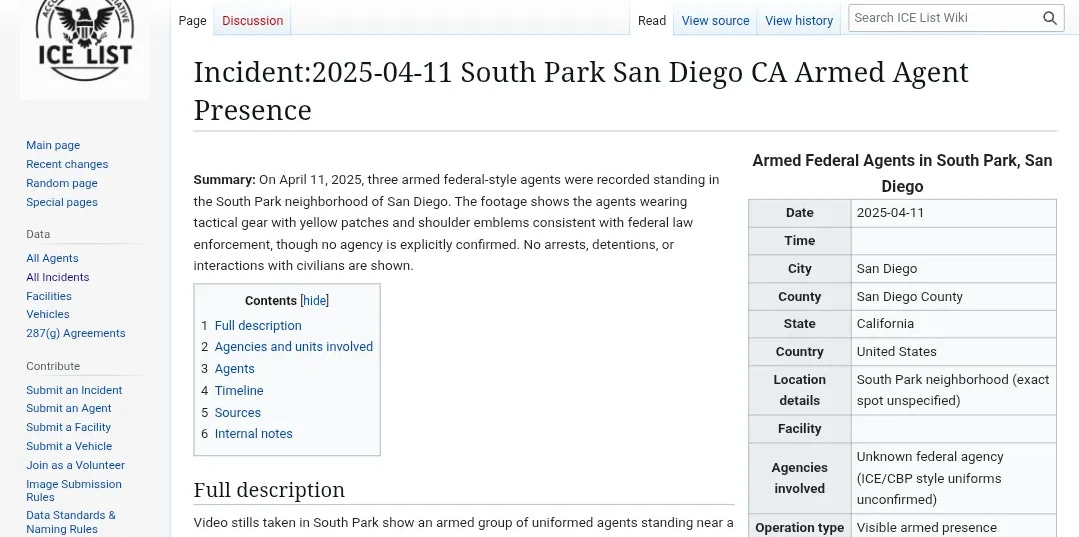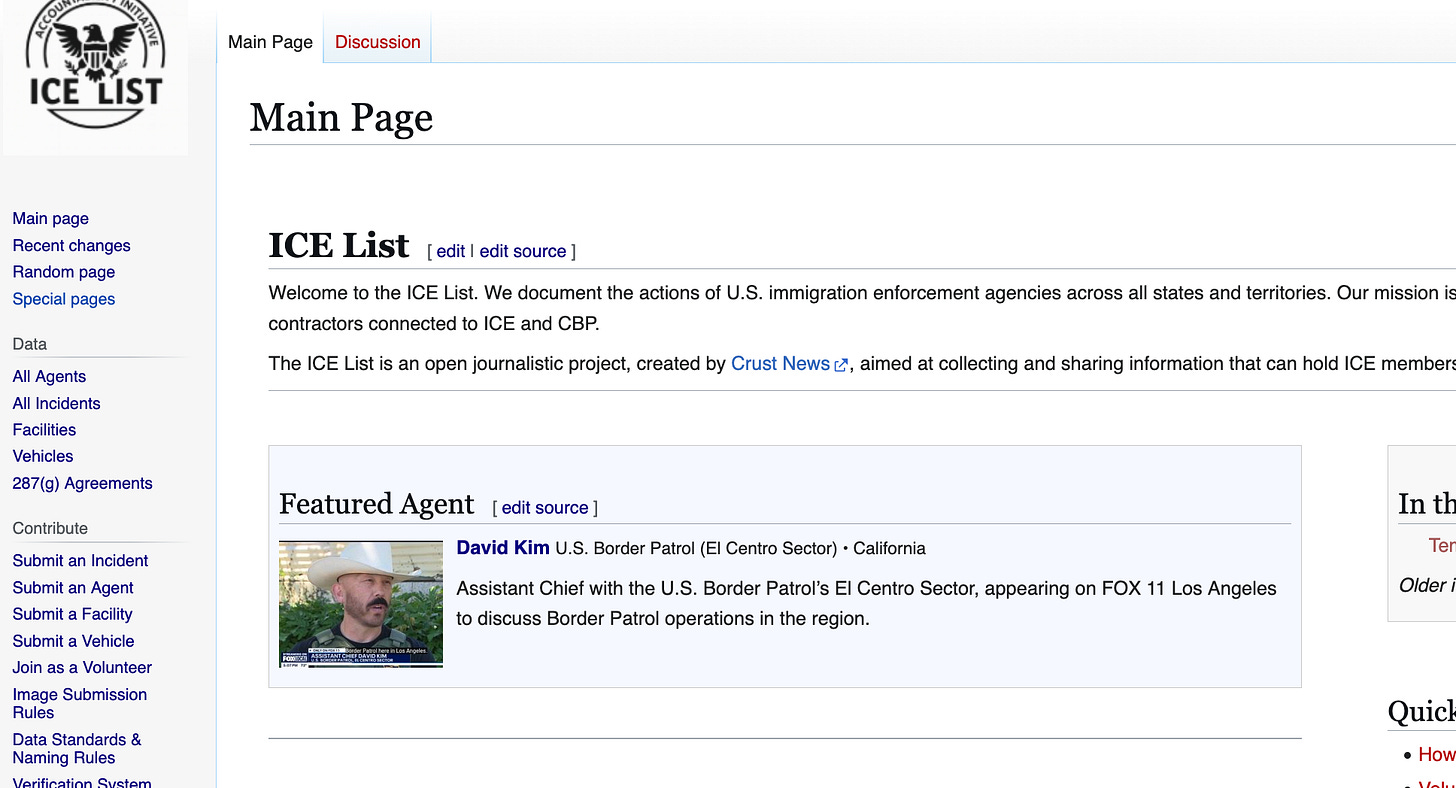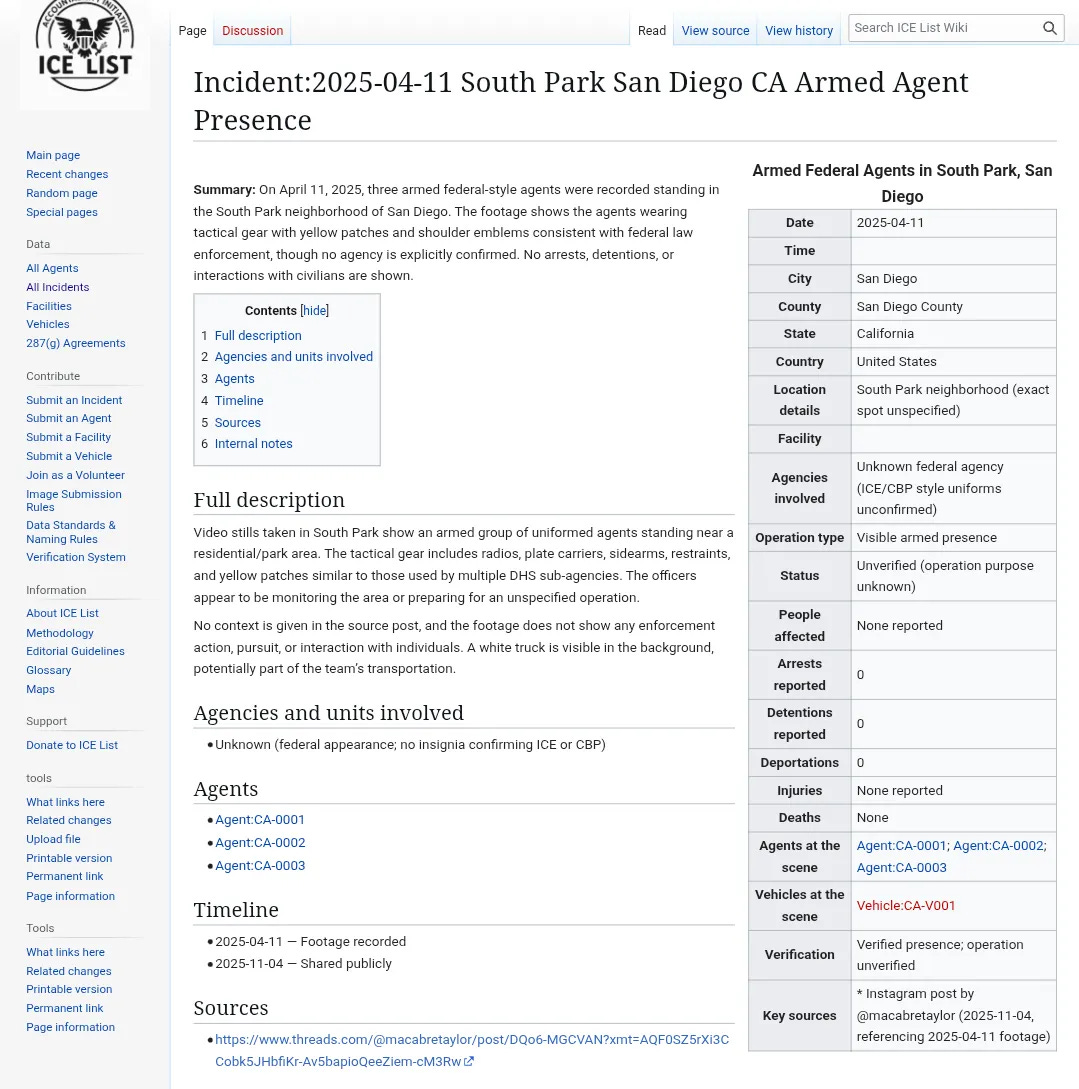We’re Building the Wikipedia of ICE Activity, Crimes and Identities
A wealth of ICE data needs a home, we're building it
When you start looking closely at immigration enforcement in the United States, you realise the problem isn’t just what ICE does, it’s that almost none of it is recorded anywhere that the public can actually find. There are thousands of small actions that happen quietly with no consistent paper trail, no central record, no way to trace who was involved or how often it happens. The more you look, the clearer it becomes that these gaps are used by the USA’s ruling regime to keep an air of plausible deniability. If everything is scattered and forgettable, we don’t make the connections between them, and the fans of the regime can deny there are any connections. Once you see that, you understand why something like our ICE List project has to exist.
We’ve been thrown a mountain of data in the last 6 months, so much so that it’s hard to allow you to see it, and we were unsure how to make that information most useful to you. Until I had a lightbulb moment when reading Wikipedia for another piece I was working on, we needed our own Wiki, where ICE raids would link to agents’ pages, vehicles used, news stories about the incident, etc. This way, these don’t become a scattered variety of news stories from around the web, but a single central location of everything.
What pushed this into this upcoming update wasn’t just my lightbulb moment of inspiration, we had planned a smaller version of this for internal work for a long time due to the real issue of needing volunteers, but also needing to uphold a promise of anonymity to those who want to help. We didn’t know it would be a wiki, but we knew a new method was needed, as the level of work and data simply grew to unmanagable levels.
While we had initially set ourselves the goal of identifying ICE agents, we’ve known for a little while that that wasn’t enough. The simple fact being that there was too much we weren’t sharing alongside those identities, but we didn’t have the right format to share it in. Soon, we will, we’re hoping to get the current version of this update pushed to our volunteers in the coming weeks, and once we’ve gotten our testing through that sample batch, we will be releasing it to the public. Until that point, information on agents will continue to be shared on the old ICE List website.

It will be much harder for this regime to deny any wider systematic abuse of powers when we record them all in one space or when each agent has a record of their own crimes. When information isn’t centralised, accountability becomes impossible. When accountability is impossible, nothing changes. That’s the cycle, and they benefit from it. We don’t aim to be a heroic answer to that, we simply have a practical solution to the problem, and the data to do it with.There comes a point, when you start looking closely at immigration enforcement in the United States, where you realise the problem isn’t just what ICE does, it’s that almost none of it is recorded anywhere that the public can actually find. It isn’t the dramatic stuff people imagine, it’s the thousands of small actions that happen quietly with no consistent paper trail, no central record, no way to trace who was involved or how often it happens. The more you look, the clearer it becomes that the gaps are not accidental. They’re built into the structure. They keep everything scattered and forgettable. And once you see that, you understand why something like the ICE List has to exist, not because anyone set out to make a grand project, but because the information simply wasn’t being collected anywhere else.
What pushed this into motion wasn’t inspiration, it was the frustration of trying to answer basic questions that should have obvious answers. Who was the agent in a specific incident. How many times has a certain field office shown up in a particular county. Which vehicles appear across multiple stops. These things should be trivial to look up in a functioning democracy, and yet they’re not. Every attempt leads into another dead end, another agency link that goes nowhere, another FOIA that returns with half the page blacked out. You end up realising the only way to understand the system is to build the missing record yourself, slowly, methodically, the way people once kept ledgers because nobody else would.
And the thing that becomes obvious very quickly is that the silence around ICE’s activities isn’t the result of some dramatic conspiracy, it’s the natural outcome of a bureaucracy that has no incentive to organise its own footprint. When the information isn’t centralised, accountability becomes impossible. When accountability is impossible, nothing changes. That’s the cycle. The ICE List isn’t a heroic answer to that, it’s just a practical one. If the record doesn’t exist, make one.
The Next Phase
And the next part of this project is the part we’ve been working toward for months. Each incident will have its own page, so will each agent, facility and car. We hope to be able to create the entire picture of who was there, what ICE facility or federal agency they served, what car drove them there, who was the team leader, and everything in between.
The who, the what, the where, the vehicles, the supporting police departments, the field offices, the contractors tied into it, all of it in one place so that nothing sits alone and nothing gets lost in a pile of unrelated posts. Every incident links to every agent who took part. Every agent links back to every incident they appear in. You will be able to start anywhere and trace the structure outward until the whole network is visible to you.
We’re documenting the vehicles because anyone who has paid attention knows vehicles are often the first clue. The same SUV showing up in different states, and the many license plates that they use. These vehicles will have their own pages, and the sightings will be listed so the public can finally follow the patterns that enforcement agencies hope nobody notices.
It’s Not Just ICE
ICE rarely acts alone, we’re tracking the police departments that help them too. Some do it openly through 287g agreements, a dodgy piece of paper that allows ICE to become the boss of other agencies. Others assist on site, sometimes in violation of the wishes of their state govorner, police sargeant and serving population. American citizens deserve to know what law enforcement offices stand with them, and which ones stand with Trump. Those departments will have profiles too, and their involvement will be visible every time it happens.
Everything will be connected, nothing will be allowed to sit in isolation the way ICE prefers it anymore. Their actions will be tied to names, their names tied to incidents, incidents tied to counties, counties tied to agreements, agreements tied to contractors, and the contractors tied right back to the agencies feeding them money. Once you can see the full chain, the idea of plausible deniability disappears and the record itself makes its own argument.
The Bigger Picture
We’ll also be keeping a continuous archive of ICE in the news, because the reporting on these agencies is inconsistent at best. We will do our best to ensure every story mentioning ICE, from the smallest local outlet to the national pieces, will be catalogued by date and state so you can see exactly when something happened and how it was covered. These will be archived within incident pages, so you can see for yourself how a specific raid was handled by each media source, and hopefully, you can make your own judgements on who to trust on this topic.
And then there’s the part that helps people understand the bigger picture. We are determined to allow people to understand the legality of what is happeniung to them, by dedicated an area to the legal structures ICE depends on, the loopholes they exploit, the programs that empower them, and the obligations they routinely ignore. A clear, simple set of pages that explain the architecture of enforcement in plain language, because the opacity of the system is part of its strength, and taking that opacity away puts the power back where it should be, in the hands of voters.
The story in all of this is not about us, or the ICE List project. The story behind all of this is that it is necessary in 2025. A regime is running the USA that is more dangerous than almost any that came before it, and through their actions, we have been forced into acting. We’re not the only ones, with incredible work being done across the USA, and projects like StopICE.net taking a stand out of complete necessity.
The simple fact is, we’re making a Wiki of ICE data, because it has become necessary. It is our promise that we will continue to do the work we see as necessary, until it no longer is.
We’re aware that many out there may have data they want to contribute towards this project, or indeed, help expand it in some other capacity. Please email the project’s private proton mail icelistcd@pm.me if you wish to get in contact.
If the work we do is imprtant to you, we would ask you to please consider becoming a free or paid subscriber to Crust News.
The update is a monster project, and is taking quite a lot of time, and costing us a little bit of money. If you’re in a position to be able to make a donation to lighten the burden of that, we would be greatly appreciative. Thank you all for your continued help and support.







